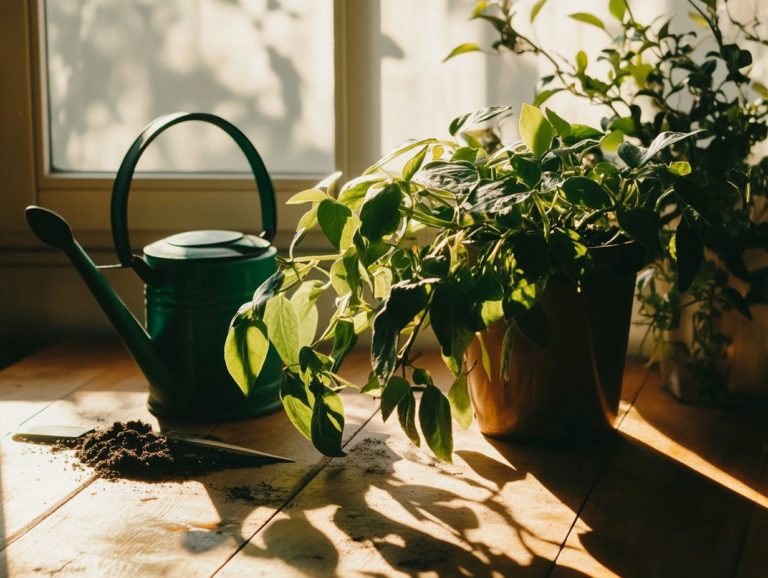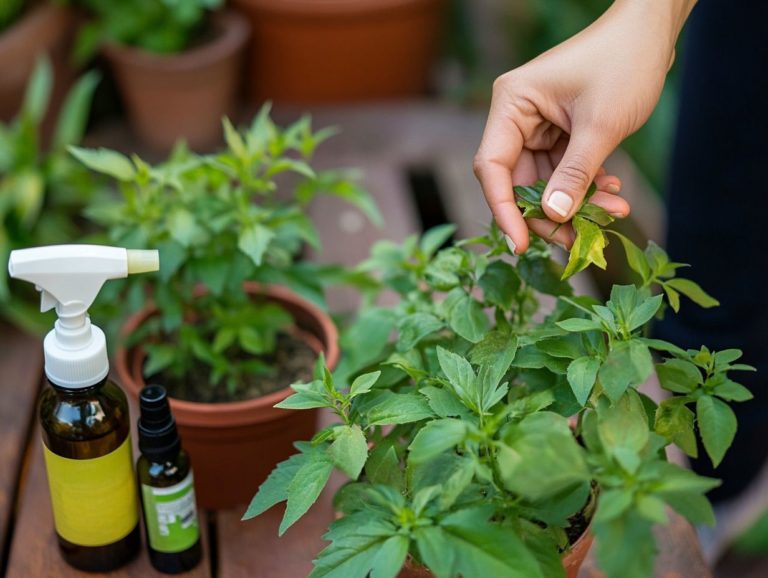How to Create a Healthy Indoor Environment
A healthy indoor environment is vital for your well-being. It affects indoor air quality, which influences both physical and mental health.
A clean home fosters relaxation and productivity.
When indoor air quality suffers, it can lead to various health issues stemming from common pollutants and contaminants that often go unnoticed.
This article delves into identifying these hazards and provides practical solutions to elevate your air quality and ensure a clean home. From cleaning tips to strategies for reducing allergens, you ll uncover how simple changes can transform your living space into a safe haven that nurtures both your body and mind.
Contents
- Key Takeaways:
- The Importance of a Healthy Indoor Environment
- Identifying Indoor Air Pollutants
- Ways to Improve Indoor Air Quality
- Creating a Clean and Safe Living Space
- Reducing Allergens and Irritants
- Promoting Mental and Emotional Well-being
- Frequently Asked Questions
- What steps can I take to create a healthy indoor environment?
- How can I improve the air quality in my home?
- What are some common sources of indoor air pollution?
- How does poor indoor air quality affect our health?
- What are some ways to reduce exposure to indoor air pollutants?
- Can indoor plants really improve indoor air quality?
Key Takeaways:

- A healthy indoor environment is crucial for our overall well-being.
- Identify and eliminate sources of indoor air pollutants to improve air quality.
- Regular cleaning and maintenance, along with natural and artificial solutions, can create a clean home and safe living space.
The Importance of a Healthy Indoor Environment
Focusing on elements such as humidity control, efficient air purification, and the use of natural materials is essential to optimizing your indoor environment. Incorporating wellness concepts like design that connects you to nature deepens your connection to your surroundings.
Recognizing the significance of these factors gives you the power to develop healthy buildings that cater to your needs.
Effects of Poor Indoor Air Quality
Poor indoor air quality can take a serious toll on your health, leading to issues like respiratory problems and cognitive decline. Pollutants like harmful chemicals from paints and cleaners, pet dander, and even carbon monoxide can quietly accumulate in your home, worsening allergies and triggering asthma attacks.
Exposure to these contaminants might lead to headaches, fatigue, and even long-term health complications. This highlights the urgent need to monitor your indoor air quality now!
Recent studies reveal that about 30% of urban dwellers report respiratory diseases linked to indoor air quality problems. VOCs, often emitted from everyday household items like paints and cleaning products, aren t just irritants; they can lead to severe conditions like liver damage and nervous system disorders.
Similarly, carbon monoxide a colorless, odorless gas from faulty heating systems poses serious risks, contributing to over 20,000 emergency room visits each year. Pet dander can trigger allergic reactions and asthma in sensitive individuals, highlighting the hidden dangers present in many homes.
Proactively addressing these pollutants can significantly enhance your overall health and well-being.
Identifying Indoor Air Pollutants
Identifying indoor air pollutants is an essential step in improving your indoor air quality and cultivating a healthier living environment. Common culprits include harmful chemicals lurking in many household cleaning products, construction materials, and various building materials.
Contaminants like dust, mold, and carbon monoxide can compromise your indoor environment. By employing air quality monitors, you can detect these pollutants, paving the way for effective remediation strategies and ensuring your home remains a pristine sanctuary.
By making these changes today, you can breathe easier and live healthier!
Identify Hidden Air Pollutants in Your Home
Common sources of indoor air pollution often lurk in your home, from the cleaning products you choose to the materials used in construction. Volatile organic compounds (VOCs), which are chemicals that easily evaporate into the air, frequently escape from paints, furniture, and cleaning supplies, significantly impacting your indoor air quality. Pet dander adds to the allergen mix. If humidity isn t properly controlled, mold can thrive, further compromising your indoor sanctuary.
It s crucial to recognize that everyday items like aerosol sprays, air fresheners, and even unvented gas stoves can worsen indoor air quality. Homeowners should be mindful that construction materials may harbor harmful substances such as formaldehyde and asbestos, which can be released over time.
To tackle these concerns, controlling humidity levels is essential. Maintaining a relative humidity between 30% and 50% can prevent mold growth and keep dust mites at bay. Simple practices like using exhaust fans while cooking, ensuring adequate ventilation, and opting for low-VOC products can help you create a healthier indoor environment.
Ways to Improve Indoor Air Quality

Improving your indoor air quality requires a comprehensive approach that combines effective air purification, humidity control, and the thoughtful selection of natural materials. By implementing an HVAC system with MERV filters, you can significantly reduce airborne contaminants. Regular maintenance keeps everything running smoothly.
You can also add plants to your space and opt for natural cleaning products to further enhance your home s environment, creating a cleaner atmosphere. These strategies work together to foster a healthier indoor setting, making them essential for cultivating a sustainable and comfortable living space.
Natural and Artificial Solutions
Both natural and artificial solutions are vital in enhancing your indoor air quality and cultivating a healthier living space. Natural materials, such as houseplants like Spider plants and Boston ferns, effectively absorb indoor pollutants while also elevating the aesthetic appeal of your home. Meanwhile, air purification systems equipped with HEPA or MERV filters provide robust protection against airborne contaminants. Together, these approaches facilitate effective humidity control and foster a clean, safe environment.
Start transforming your indoor space today! Placing a few carefully selected plants alongside a high-efficiency air purifier can enhance the benefits of each method. Houseplants not only reduce volatile organic compounds (VOCs) but also promote a sense of well-being with their lively presence. Air purification systems tackle particles that houseplants might overlook, ensuring every corner of your space is accounted for.
To embark on this journey, start with a few easy-to-care-for plants, like pothos or peace lilies, paired with a compact air purifier tailored for the size of your room. Regular upkeep of both the plants and the air purifier will guarantee lasting improvements in your air quality.
Creating a Clean and Safe Living Space
Creating a pristine and secure living environment demands consistent upkeep, efficient cleaning routines, and a dedication to enhancing indoor air quality.
Regular deep cleaning goes beyond merely removing dust and allergens; it actively safeguards against harmful contaminants. Implementing smart home safety measures like selecting the right cleaning products and ensuring proper ventilation is crucial for cultivating a healthy indoor atmosphere.
By prioritizing these practices, you can greatly elevate the quality of your indoor spaces. Start implementing these tips today for immediate benefits!
Cleaning and Maintenance Tips
Effective cleaning and maintenance practices are essential for ensuring a high standard of indoor air quality. They directly contribute to a pristine home atmosphere. Regular carpet cleaning, using safe cleaning products, and maintaining proper air circulation are crucial steps in banishing dust, allergens, and other pollutants from your living space.
Integrating humidity control measures can thwart the growth of mold and mildew, fostering a healthier indoor environment.
When selecting safe cleaning products, look for options free from harsh chemicals that carry eco-friendly certifications. Such choices can tackle grime effectively while being gentle on your health and the planet.
For carpet cleaning, techniques like steam cleaning or dry extraction not only eliminate dirt but also rejuvenate the fibers, enhancing the overall look and feel of your carpets.
To boost air circulation, consider using fans or frequently opening windows. Keep an eye on humidity levels with a dehumidifier to maintain optimal conditions.
By adopting these strategies, you can transform your home’s air quality for a cleaner, more refreshing indoor environment.
Reducing Allergens and Irritants
Reducing allergens and irritants in your home is essential for enhancing indoor air quality and supporting your overall well-being. Common culprits like pet dander, dust mites, and mold can worsen respiratory problems and provoke allergic reactions.
Using good cleaning habits, employing high-quality air filters, and maintaining optimal humidity levels can significantly diminish the presence of these irritants. This proactive approach cultivates a healthier indoor environment and helps you learn how to foster a pest-resistant indoor environment for you and your loved ones.
Strategies for Allergy Relief

Implementing effective strategies for allergy relief is crucial for maintaining high indoor air quality and ensuring your living environment remains comfortable. Using allergen-reducing cleaning products, regularly eliminating common sources of allergens, and employing air purification systems can significantly alleviate your allergy symptoms.
These strategies not only purify the air but also enhance the overall cleanliness and safety of your healthy home features. Act now to create your personal sanctuary that minimizes triggers and fosters well-being.
Regularly wash your bedding in hot water, use protective covers on mattresses, and vacuum with high-efficiency air filters that trap small particles to take practical steps. Keep humidity levels in check to prevent mold growth, and choose low-VOC (volatile organic compound) paints and furnishings to further boost air quality.
When you combine these efforts, you ll likely experience a noticeable reduction in symptoms. This will allow you to breathe easier and enjoy your indoor spaces with far less concern about indoor pollutants.
Promoting Mental and Emotional Well-being
Promoting mental and emotional well-being is closely connected to the quality of your indoor environment. A thoughtfully curated space that embraces design elements that connect with nature can significantly uplift your mood and enhance cognitive function.
By incorporating elements like natural light, houseplants, and clean air, you create an atmosphere that nurtures mental health and fosters a sense of calm.
Recognizing these connections empowers you to design spaces that not only support a healthy lifestyle but also elevate your overall well-being, enhancing your indoor environmental quality.
The Link Between Indoor Environment and Mental Health
The connection between your indoor environment and mental health is gaining recognition in research. Elements like indoor air quality, lighting, and natural materials can profoundly influence your emotional well-being.
Cluttered spaces or those laden with pollutants can escalate stress and anxiety. In contrast, a thoughtfully designed, clean home fosters relaxation and mental clarity, enhancing overall wellness and promoting home safety.
Recent studies, including those from Harvard University, reveal that indoor air quality can impact cognitive function by as much as 50%. Good ventilation is crucial for a refreshing indoor space, along with the use of non-toxic materials and effective heating, ventilation, and air conditioning systems.
Bright, natural light improves mood. A significant study from the University of Michigan found that participants felt more satisfied in well-lit environments, highlighting the benefits of energy efficiency.
To boost your emotional well-being, consider adding houseplants like Spider plants, Chinese Evergreen, and Boston ferns. These plants purify the air and elevate your space s aesthetics. Research shows that greenery can effectively lower stress levels.
Decluttering your surroundings and opting for calming color palettes cultivates a sense of harmony. This practice makes it easier to feel grounded and focused in daily life while reducing moisture problems and enhancing overall well-being.
Frequently Asked Questions
What steps can I take to create a healthy indoor environment?
To create a healthy indoor environment, start by keeping your home clean and well-ventilated. Regularly dust, vacuum, and open windows to let in fresh air. Additionally, use non-toxic cleaning products and reduce clutter to improve indoor air quality and enhance home safety.
How can I improve the air quality in my home?

To improve air quality in your home, use air purifiers, regularly change air filters, and keep humidity levels between 30-50%. You can also try using indoor plants, which help remove toxins from the air and act as a natural ventilation system.
What are some common sources of indoor air pollution?
Indoor air pollution can originate from various sources, including household cleaning products, construction materials, and outdoor pollutants. Mold, pet dander, and tobacco smoke also contribute to poor air quality, impacting overall health.
How does poor indoor air quality affect our health?
Poor indoor air quality can significantly impact our health, leading to respiratory issues, allergies, and even chronic conditions such as asthma. It can also affect cognitive function and overall well-being, highlighting the importance of air quality monitors.
What are some ways to reduce exposure to indoor air pollutants?
To reduce exposure to indoor air pollutants, regularly clean and maintain your home. Use natural and non-toxic cleaning products and avoid smoking indoors. Ensure proper ventilation and limit the use of products that emit strong odors or chemicals while maintaining humidity control.
Can indoor plants really improve indoor air quality?
Yes, indoor plants can help improve air quality by absorbing harmful pollutants and releasing oxygen. Some of the most effective air-purifying plants include snake plants, spider plants, Bamboo Palm, and peace lilies.
Start transforming your space today for a healthier, happier you!






